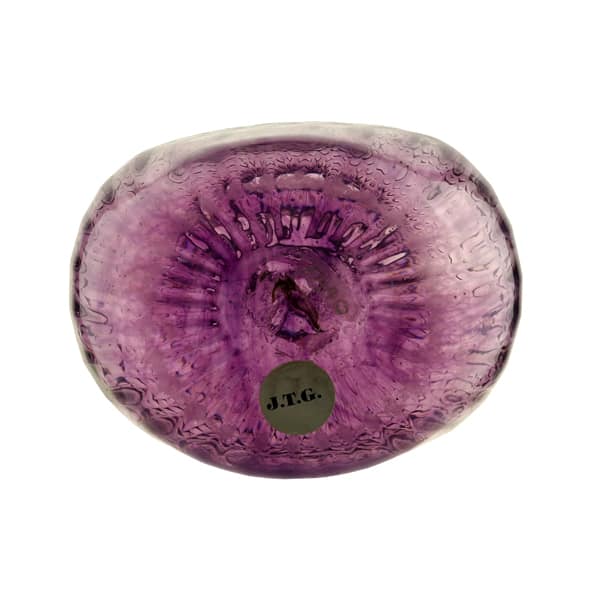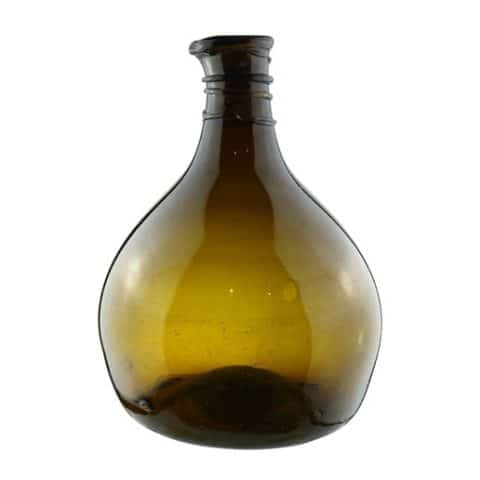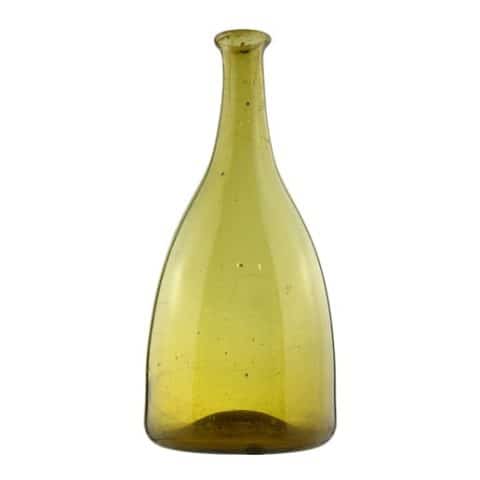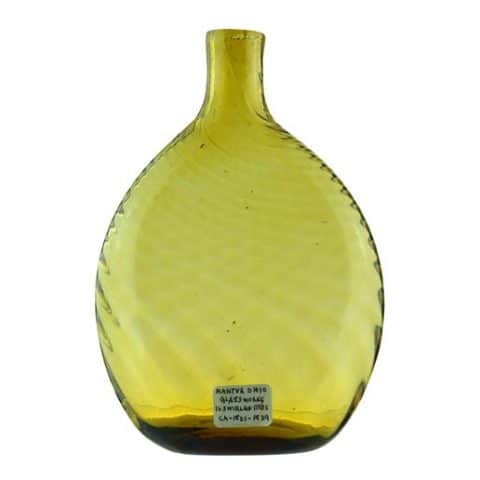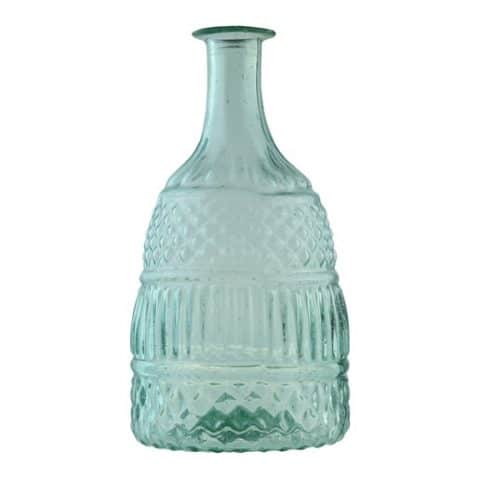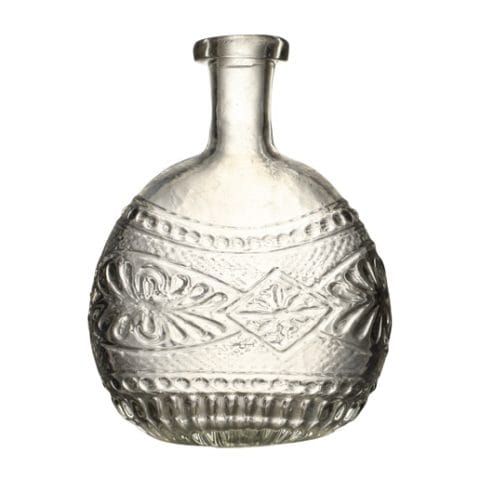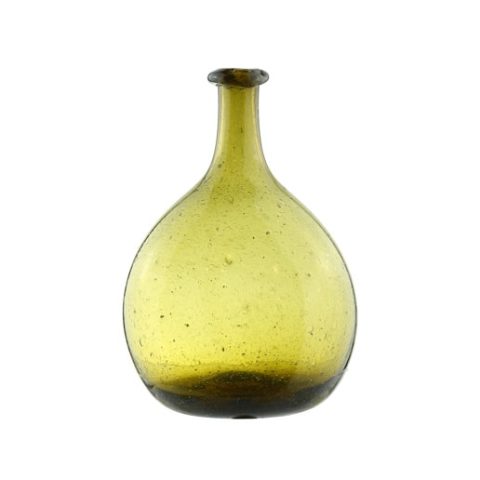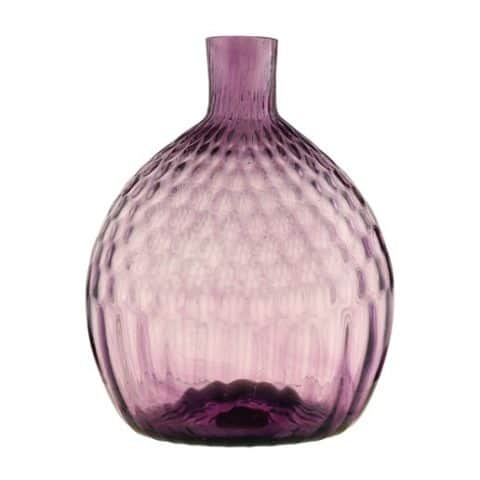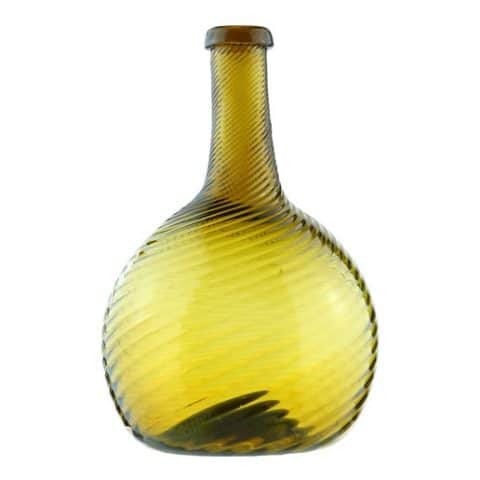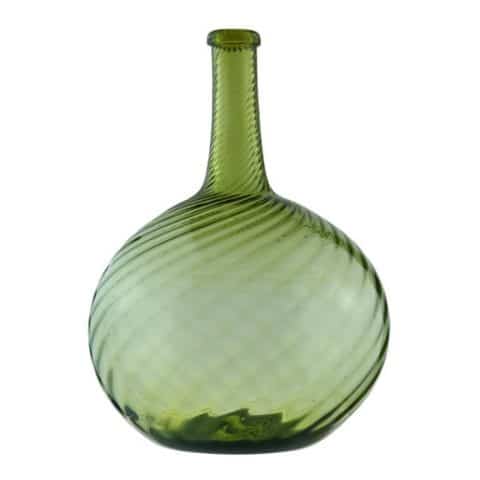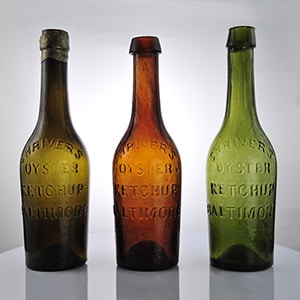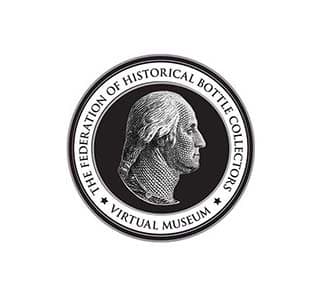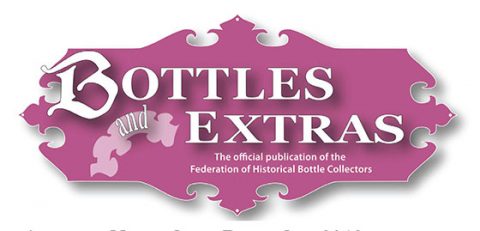Stiegel Type Pocket Bottle (MG42)
Stiegel Type Pocket Bottle
Honeycomb over flutes pattern
Early American Blown Glass
Attributed to Stiegel’s American Flint Glass Manufactory, Manheim, Pennsylvania
Light to Medium Pink Amethyst Pattern Molded Glass
Provenance: Michael George Collection, ex-John Tiffany Gotjen Collection, ex-Gary, and Arlette Johnson Collection
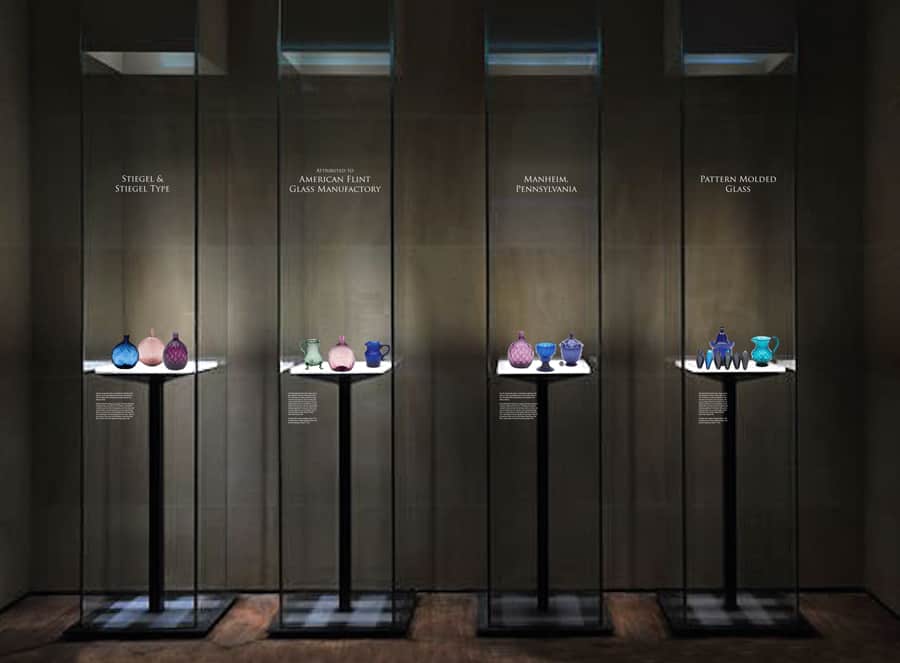
On display in our Early American Glass wing within the Blown Pattern Molded Gallery, we present this wonderful 5″ tall honeycomb over flutes pattern Stiegel Type Pocket Bottle in a light to medium pink amethyst glass coloration. The piece is attributed to Henry William Stiegel and his American Flint Glass Manufactory in Manheim Pennsylvania from 1769 to 1774.
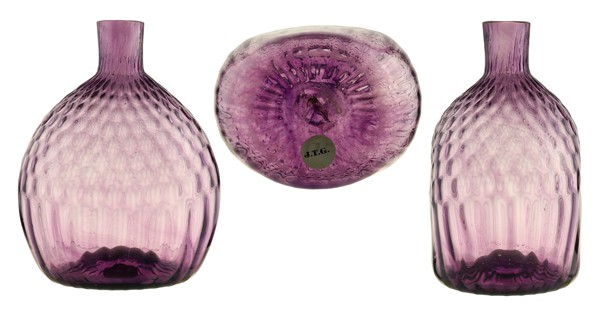
Henry William Stiegel is best known as a German-American glassmaker and ironmaster. He was born on May 13, 1729, in Cologne, Germany. Stiegel was the eldest of six children born to John Frederick and Dorothea Elizabeth Stiegel in the Free Imperial City of Cologne. He immigrated to British North America in 1750 with his mother and younger brother, Anthony as his father and other siblings had died. The Stiegel’s sailed on the ship Nancy and arrived in Philadelphia, Pennsylvania on August 31, 1750.
After arriving, Stiegel took a job at the busy wharves of Philadelphia with Charles and Alexander Stedman, most likely as a clerk or bookkeeper. The Stedman’s were prominent English ship-faring merchants and port agents who years before had escaped persecution in Scotland after a failed attempt to support a retaking of the Crown.
In 1752, Stiegel moved to what is now Lancaster County, Pennsylvania to work with Jacob Huber, an ironworker. He married Huber’s daughter, eighteen-year-old Elizabeth, the same year. The couple had two daughters, Barbara, born in 1756, and Elizabeth born in 1758. Elizabeth Huber Stiegel died on February 13, 1758, only ten days after giving birth to their second daughter. Stiegel married his second wife, Elizabeth Holtz, within a year. They had a son named Jacob.
When Jacob Huber retired in 1758, Stiegel and several business partners from Philadelphia assumed ownership and operation of Huber’s foundry and renamed it, Elizabeth Furnace, in honor of his wife. They made kettles, pans, and sugar boiling equipment. Stiegel later purchased another forge in Berks County near Lancaster called the Tulpehocken Eisenhammer to support the operations at Elizabeth Furnace. He called the place Charming Forge.
Stiegel next turned his attention to the glass-making industry. At the time, the majority of glassware was imported to the colonies and priced so high that it was considered a luxury item. After a trial period of glass blowing at Elizabeth Furnace, Stiegel founded the American Flint Glass Manufactory near Manheim, Pennsylvania in 1763. Initially, the firm made utilitarian bottles and window glass. He enlarged the plant several times and hired skilled workmen from the European glassmaking centers, which contributed materially to the quality and variety of tableware and chemical ware manufactured at the works. Later, the factory produced blown glass tableware, including wine glasses, cream pitchers, salt dishes, pocket bottles, and sugar bowls all in vibrant blue, green, and purple colors. Extensive newspaper advertising brought increased patronage from the cities of Philadelphia, New York, and Boston and from nearby towns in Pennsylvania as his glass was now equal to that imported from Europe. He now was very successful in glassmaking and the iron industry. At some point thereafter, Stiegel was dubbed “Baron” and the title has persisted, and even to this day he is spoken of and written of, as Baron Von Stiegel.
An active Lutheran and associate of Henry Melchior Muhlenberg, Stiegel donated the land on which the Lutheran church in Manheim, Pennsylvania is now built. Stiegel was also a founding member of the German Society of Pennsylvania, formed in 1764 to aid newly arrived German immigrants. He led the fundraising efforts to secure the plot of land on which the Society’s first building was eventually erected. Stiegel’s wealth provided him with the means to construct a brick mansion in Manheim and furnish it with a lavish interior. He held Lutheran services on the second-floor chapel. Imported Delft tiles, depicting various Biblical scenes, surrounded the fireplace. Two large painted wall-hangings, which featured a hunting party on horseback, graced the ballroom walls. He loved music and purchased several instruments including a harpsichord. His loyal employees played the instruments for their master’s enjoyment upon a roof-top balcony. According to folklore, Stiegel erected a tower and placed a cannon on top. The cannon was supposedly fired to welcome him home after extended periods of travel.
Economic conditions were uncertain after the French and Indian War and the British colonies were growing restless. Stiegel acquired large amounts of real estate surrounding his home, glass factory, and iron furnace, totaling over 14,000 acres in all. This, combined with his lavish lifestyle, meant he was unable to repay his partners and investors. Selling his property and possessions was not enough and he was ultimately thrown into debtor’s prison in late 1774. Released by an order of the Colonial Assembly, Stiegel relied upon his relatives for support and worked as the bookkeeper at Elizabeth Furnace, then owned by his nephew, and later as a school teacher. Henry William Stiegel was never able to recover from his indebtedness and died a pauper on January 10, 1785. In 1934, the Lancaster County Historical Society erected a memorial to Stiegel in Manheim, Pennsylvania.
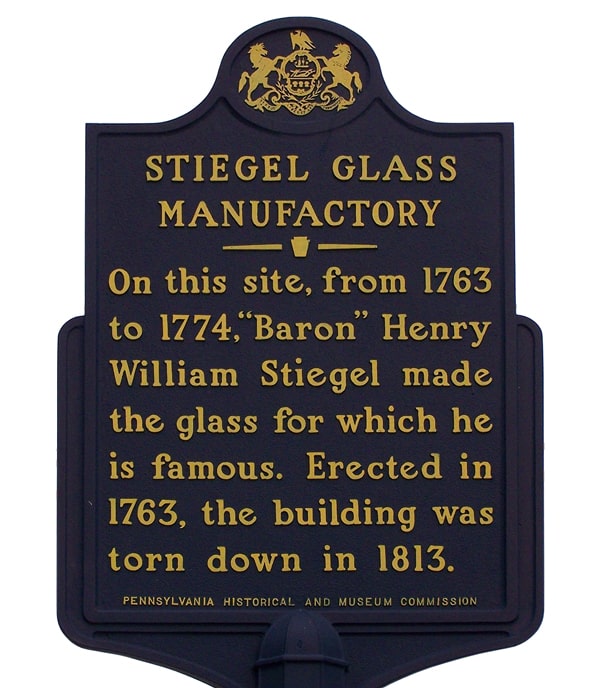
Primary Image: Stiegel Type Pocket Bottle, imaged on location by the FOHBC Virtual Museum midwest studio led by Alan DeMaison.
Support: Reference to American Bottles and Flasks and Their Ancestry by Helen McKearin and Kenneth M. Wilson, Crown Publishers Inc., New York, 1978.
Support: Reference to History of Manheim and “Baron” Henry William Stiegel, Manheim Historical Society
Support: Reference to Henry William Stiegel – Ironmaster and Glass Maker by Valerie Seiber
Support Image: Auction Lot 244: Stiegel Pattern-Molded Amethyst Glass Pocket Flask, Circa 1770, Height 5 inches. For a similar example, see Arlene Palmer, Glass in Early America, Winterthur, Delaware: 1993, pp. 361-364. See also: Frederick William Hunter, Stiegel Glass, Dover Publications, Inc., New York: 1950, cover illustration and pl. II. – Doyle Auctions, November 17, 2011
Support Image: Pattern Molded Pocket Flask, Henry William Stiegel’s American Flint Glass Manufactory, Manheim, PA, 1769 – 1774. Medium amethyst, 28 diamonds over flutes, plump horseshoe form, sheared mouth – blowpipe pontil scar, ht. 5″; (a ¼” chip on edge of lip; a ¼” in-making, surface annealing line near base). McK, plate 9, #5. An early collector tag remains on the shoulder. The flask originated from a collection assembled back in the 1920s. An outstanding example of Colonial Period glass, beautiful light color, and clarity.
Support Image: Auction Lot 33: Pattern Molded Pocket Flask, 28 ogival diamonds or “honeycomb pattern” over flutes, probably Stiegel’s American Flint Glass Manufactory, Manheim, Pennsylvania, 1769–1774. Grape amethyst, plump horseshoe form, sheared mouth – pontil scar, ht. 5 1/8”, near mint; (somewhat weakened impression in lower body and some scattered light exterior high point wear). A beautiful, vivid color, classic form, and pattern (see, Glass in Early America, Arlene Palmer, #353). – John Pastor, American Glass Gallery, Auction #9
Support Image: Auction Lot 111: Pattern Molded Pocket Bottle, twelve “nipt” diamond pattern, probably Stiegel’s American Flint Glass Manufactory, Manheim, Pennsylvania, 1770-1774. Plump pocket bottle form, brilliant medium amethyst, sheared mouth – pontil scar, ht. 5 inches; (some minor exterior high point wear). Similar to MW plate II #2 Beautiful color, fine condition. Ex John Tiffany Gotjen collection. – Norman Heckler Jr. & Sr., Norman C. Heckler & Company, Auction #98
Support Image: Pocket bottle, Blown pattern-molded glass, 1764–74, Attributed to American Flint Glass Manufactory. Attributed to Henry William Stiegel (American (born Germany), Cologne 1729–1785 Charming Forge, Pennsylvania). The diamond-daisy pattern on this amethyst-colored pocket flask may have been introduced by Stiegel; it is not found on European examples. Many variations of this popular design exist, as seen in other pieces in the collection (see 1980.502.68 and 14.74.17). Title: Pocket bottle Dimensions: H. 5 in. (12.7 cm) Credit Line: Gift of Mrs. David Dows, 1934 – On view at The Met Fifth Avenue in Gallery 704, Metropolitan Museum of Art, N.Y.C.
Support Image: Auction Lot 7: Stiegel Type Pattern Molded Flask, twenty diamonds over sixteen fluted ribs pattern, possibly Stiegel’s American Flint Glass Manufactory, Manheim, Pennsylvania, 1783-1800. Coin form, brilliant medium lavender, sheared mouth – pontil scar, ht. 6 1/8 inches. See 1938 Parke Benet catalog of William Van Winkle collection for a nearly identical example. Beautiful color. Fine condition. – Norman Heckler Jr. & Sr., Norman C. Heckler & Company
Join the FOHBC: The Virtual Museum is a project of the Federation of Historical Bottle Collectors (FOHBC). To become a member.

